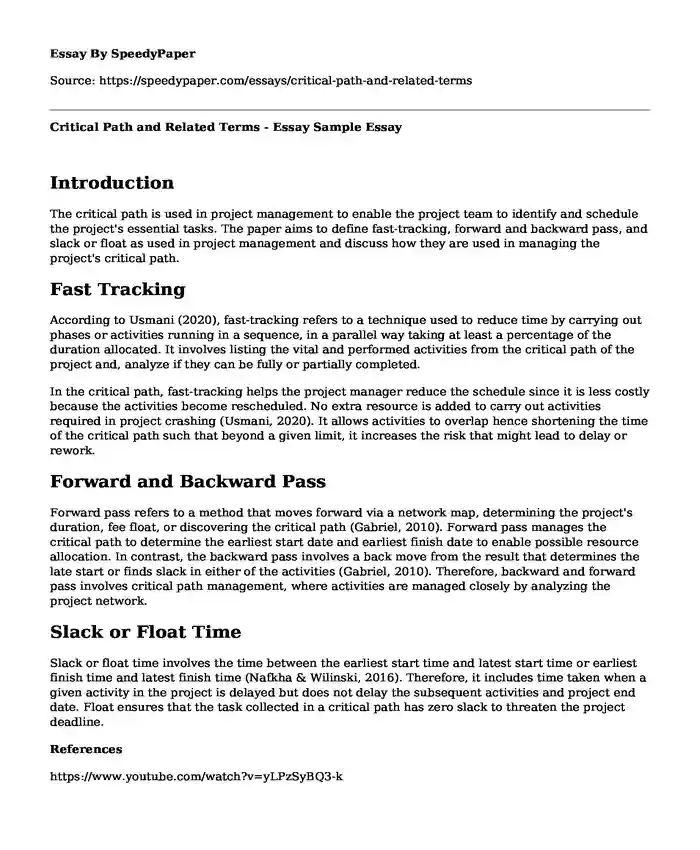
| Type of paper: | Essay |
| Categories: | Project management Management |
| Pages: | 2 |
| Wordcount: | 436 words |
Introduction
The critical path is used in project management to enable the project team to identify and schedule the project's essential tasks. The paper aims to define fast-tracking, forward and backward pass, and slack or float as used in project management and discuss how they are used in managing the project's critical path.
Fast Tracking
According to Usmani (2020), fast-tracking refers to a technique used to reduce time by carrying out phases or activities running in a sequence, in a parallel way taking at least a percentage of the duration allocated. It involves listing the vital and performed activities from the critical path of the project and, analyze if they can be fully or partially completed.
In the critical path, fast-tracking helps the project manager reduce the schedule since it is less costly because the activities become rescheduled. No extra resource is added to carry out activities required in project crashing (Usmani, 2020). It allows activities to overlap hence shortening the time of the critical path such that beyond a given limit, it increases the risk that might lead to delay or rework.
Forward and Backward Pass
Forward pass refers to a method that moves forward via a network map, determining the project's duration, fee float, or discovering the critical path (Gabriel, 2010). Forward pass manages the critical path to determine the earliest start date and earliest finish date to enable possible resource allocation. In contrast, the backward pass involves a back move from the result that determines the late start or finds slack in either of the activities (Gabriel, 2010). Therefore, backward and forward pass involves critical path management, where activities are managed closely by analyzing the project network.
Slack or Float Time
Slack or float time involves the time between the earliest start time and latest start time or earliest finish time and latest finish time (Nafkha & Wilinski, 2016). Therefore, it includes time taken when a given activity in the project is delayed but does not delay the subsequent activities and project end date. Float ensures that the task collected in a critical path has zero slack to threaten the project deadline.
References
https://www.youtube.com/watch?v=yLPzSyBQ3-k
Gabriel, F. (2010). Management Science Applications in Project Management. Retrieve from ENCE 424 Projects, Dr. Steven A. Gabriel, University of Maryland (umd.edu)
Nafkha, R., & Wilinski, A. (2016). The critical path method in estimating project duration. Information Systems in Management, 5(1), 78-87. https://www.infona.pl/resource/bwmeta1.element.baztech-c3d822db-42f7-4ad8-8b40-25acdb0518f9
Usman, F. (2020). Fast Tracking and Crashing – Schedule Compression Techniques in Time Management. Retrieve from https://pmstudycircle.com/2012/09/fast-tracking-crashing-schedule-compression-techniques-in-time-management/#
Cite this page
Critical Path and Related Terms - Essay Sample. (2024, Jan 28). Retrieved from https://speedypaper.net/essays/critical-path-and-related-terms
Request Removal
If you are the original author of this essay and no longer wish to have it published on the SpeedyPaper website, please click below to request its removal:
- Essay Sample with the Analysis of the Articles Dedicated to Working Capital Management
- Time Management Development - Free Essay Sample
- Free Essay. Impact of Low-Interest Rate Environment on the Time Value of Money
- Free Essay. Management Plan Professionalism
- Essay Sample on Personal and Social Development Issues Strategies
- Free Essay Sample on Healthcare Leadership and Management
- Exploring Leadership in Project Management: Factors, Styles, and Success Strategies - Paper Sample
Popular categories




